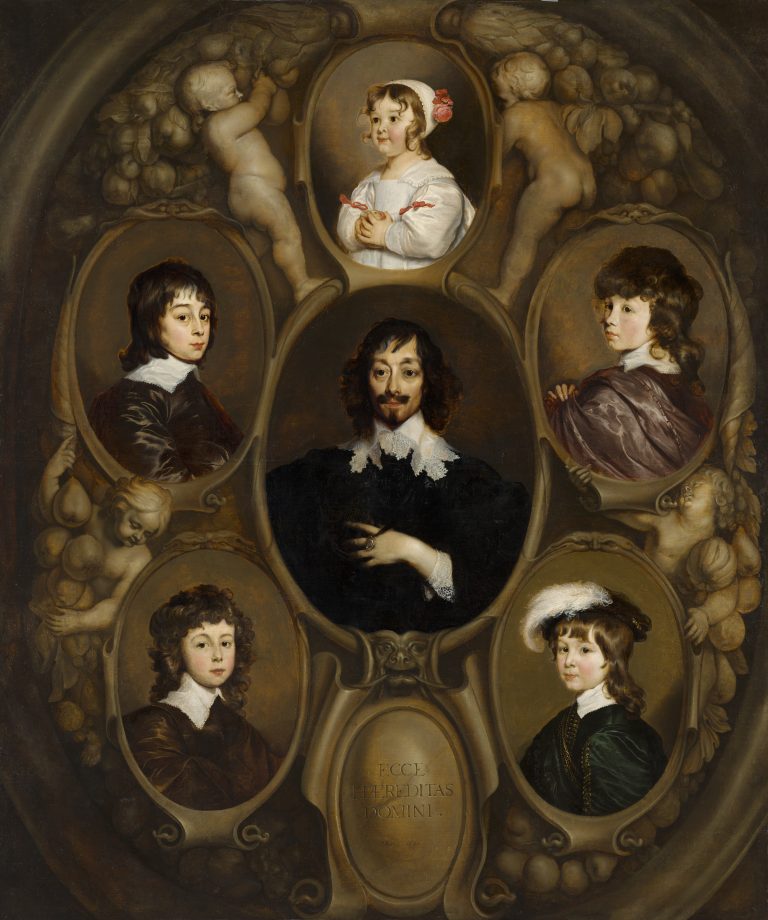If you are driving on the Scheveningseweg, on the corner of Ary van der Spuyweg you may see the bust of Constantijn Huygens. It is there because Huygens was the first to come up with a plan for this road. It would be nice if you also had the music composed by this 17th century homo universalis in your head as you drove by.
Music lessons as a young child
In 1601, when Constantijn was 5 years old, he and his brother received their first music lessons. They learned singing and sight reading. Two years later they started practising the violin and the viola da gamba and after that they got lessons in playing the lute. Especially for this instrument Constantijn proved to have a talent.
In his teens Constantijn also learned to play all kinds of keyboard instruments. In his later life he picked up the theorbo, a lute-like stringed instrument with extra bass strings. In 1627 he commissioned Thomas de Keyzer to paint a portrait with a lute on the table.
Travelling abroad
Huygens made several trips abroad, in which the music was also important. In England, he performed for King James I on a type of lute patented in 1816 as the “British harp-lute”. Two years later he travelled to Venice, where he heard the music of Claudio Monteverdi, conducted by that composer in the church of San Giovanni e Luzia.in the. On the way back from Venice the company passed through Strasbourg. Huygens clearly had no fear of heights: he climbed the spire of the cathedral tower of this city (142 metres) on the outside.
Personal life
On 6 April 1627, Constantijn Huygens married his niece Suzanna van Baerle in Amsterdam. He was very much in love with her and called her his ‘Star’.
Sadly, Suzanna died 10 years later, shortly after the birth of their fifth child.
After her death Huygens went through a difficult period, in which he moved to a beautiful house at Plein. It stood on the spot where the Department of Justice was later built, a building that is now part of the Tweede Kamer complex.
Huygens designed his country residence, “Hofwijck” in Voorburg. ‘Hof’ is the Dutch word for court and the Dutch verb ‘wijken’ means to get away from. So by choosing the name ‘Hofwijck’ he emphasised his need to get away from his busy job as secretary to Stadholder Frederik Hendrik.
The rest of this article is written by Hans Jansen, conductor of the Haags Kleinkoor
Constantijn Huygens – the composer
Huygens did not only play music, he also composed. He probably produced almost 900 pieces of music, most of which have unfortunately been lost.
Pathodia sacra et profana occupati
Not lost are the Pathodia sacra et profana occupati (Worldly and Spiritual Songs of a Busy Man). This collection from 1647 contains 39 compositions for voice and basso continuo: twenty psalms and nineteen ‘airs’, twelve on Italian poems and seven on French poems. The first word in the title, ‘pathodia’, is a ‘Huygenian neologism’, a contraction of ‘pathos’ (feeling, passion) and ‘odè’ (singing).
On the title page the name of the composer is missing. Instead it says cryptic ‘occupati ‘, ‘ from a busy man ‘. By this Huygens indicates that he is not a professional musician; in daily life he fulfils a ‘function for the public benefit’, a.o. secretary of the stadholder.
Frivolities
The airs and arias are introduced with an apology to the reader for the frivolities that follow. Because the psalms are placed at the front of the collection and the secular compositions are preceded by this short, apologetic foreword, it becomes clear that Huygens considered the psalms to be more important. Also because of the number, the emphasis is on the psalms. The nineteen airs and arias are in the minority compared to the twenty psalms.
Italiaanse muziek
Huygens was particularly touched and influenced by the new Italian music that conquered Europe from the beginning of the 17th century. Huygens was lyrical about the music of Claudio Monteverdi. He heard his music when he stayed in Venice in 1620 as a diplomat and attended a performance. He called it ‘the most perfect music I think I will ever hear in my life’
Constantijn's music
We can be proud of this Haagse composer!
Would you like to know what the music of Constantijn Huygens sounds like?
De profundis clamavi
Multi dicunt animae meae
Avertisti facies tuam
I tell you more about 17th century The Hague during my city walks and bicycle tours.








2 thoughts on “Constantijn Huygens and his music”
Thank you for the information, unfortunately the music links do not work.
Thank you for this warning. The recordings were removed from Youtube, but I found new ones. So now the links do work.